Though my taste in manga is very particular, I’m much less discriminating in my reading habits. My willingness to try anything has yielded some wonderful surprises: Ai Morinaga’s Duck Prince, Taiyo Matsumoto’s No. 5, Shioko Mizuki’s Crossroad, Kazuo Umezu’s Scary Book, Motofumi Kobayashi’s Apocalypse Meow. The flipside of being a gourmand is that I’ve encountered my share of truly dreadful stuff, too — the kind of manga with such incoherent plots, unappealing characters, clumsy artwork, and tin-eared dialogue that they beg the question, Who thought this was a good idea?
Now that I’d donned my flame-proof pants, here are my candidates for the Manga Hall of Shame:
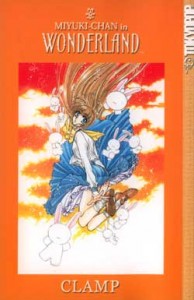 10. Miyuki-chan in Wonderland
10. Miyuki-chan in Wonderland
By CLAMP • Tokyopop • 1 volume
I’ve read my way through the highs and lows of the CLAMP canon, from the Gothic angst of Tokyo Babylon to the cutesy antics of Kobato, and can say with great confidence that this odd one-shot represents the nadir of this talented quartet’s work. Miyuki-chan probably sounded like a great idea on paper: a young girl falls down a hole and finds herself in a sexed-up version of Lewis Carroll’s famous story. Unfortunately, the story bears almost no resemblance to Carroll’s original; Miyuki-chan is really just a pretext for CLAMP to draw scantily-clad beauties engaging in vaguely naughty behavior, usually by making a pass at Miyuki or inviting her to play strip poker. The stories are short and repetitive, barely spanning 100 pages in total, and are so inane that they don’t work as pornography or parody.
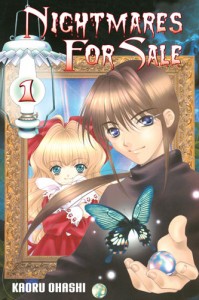 9. Nightmares for Sale
9. Nightmares for Sale
By Kaoru Ohashi • Aurora Publishing • 2 volumes
The premise of Nightmares for Sale is pure comeuppance theater: in exchange for having their dearest wishes granted – in this case, by the proprietors of Shadow’s Pawn Shop – bad people receive their just desserts. For this old-as-the-hills premise to succeed, three basic conditions need to be met. First, the audience needs to understand the subject is unrepentantly bad and not merely flawed or misguided. Second, the audience needs to see the chain of decisions that lead to the subject’s downfall. And third, the punishment needs to fit the crime. Alas, manga-ka Kaoru Ohashi doesn’t satisfy these basic criteria in Nightmares for Sale. A few characters get what they deserve, but many of the stories are sloppily executed; we don’t learn how or why the subject is being punished until Shadow appears at the end of the story to tell us. By far the worst chapter is “Children of Darkness,” in which a woman is tormented by the spirit of her unborn child. No matter what your personal convictions on abortion, the story is both macabre and misogynist, and shows an astonishing lack of compassion for the subject’s situation. Not even the artwork can redeem this clunker: it’s both busy and generic, a hot mess of awkwardly posed bodies and poorly applied screentones. (Review originally posted at PopCultureShock, 11/28/07)
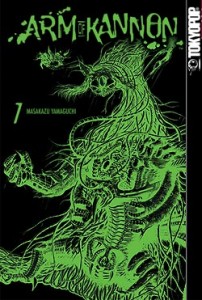 8. Arm of Kannon
8. Arm of Kannon
By Masakazu Yamaguchi • Tokyopop • 9 volumes
After a nearly three-year absence, archaeologist Tozo Mikami returns to his family with a mysterious object in tow: the Arm of Kannon, an ancient Buddhist relic that, unbeknownst to Mikami’s son Maso, is a parasitic weapon that feeds off its host’s life force while transforming him into a tentacled killing machine. Before we’re too far into volume one, the Arm of Kannon destroys Tozo, choosing Maso as its next host. What follows is an unholy marriage of gore, mystical mumbo-jumbo, and military conspiracy theories, as Maso rapes and dismembers people, gets captured by an army contractor, then kills some more. A third-act detour into the distant past adds unnecessary complications to the plot; it’s as if Yamaguchi got bored with his characters but realized that he hadn’t quite resolved things enough to simply end the story. The art is incredibly detailed, which is a mixed blessing: if you like your entrails rendered with anatomical specificity, Arm of Kannon might be your cup of tea. Anyone in search of a coherent plot or sympathetic characters, however, is advised to look elsewhere.
 7. The Devil Within
7. The Devil Within
By Ryo Takagi • Go! Comi • 2 volumes
If 98.7% of shojo heroines are kind, smart, enthusiastic, and/or sincere—read likeable—Rion, the sixteen-year-old heroine of The Devil Within is a rare outlier: she suffers from a full-on shota complex that makes her seem mentally unbalanced. Forced into choosing among three prospective fiances (all adults), Rion instead pins her hope on a young neighbor who happens to be a fifteen-year-old trapped in a five-year-old’s body. Making this whole distasteful concept even more unpalatable is the way in which manga-ka Ryo Takago treats the principle character; Rion endures truly grotesque forms of abuse from her suitors that results in her abject humiliation. Hats off to anyone who made it through the first volume without squirming — I couldn’t.
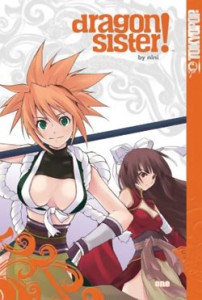 6. Dragon Sister!
6. Dragon Sister!
By Nini • Tokyopop • 2 volumes
Buried beneath the slapstick, speedlines, and extreme mammary close-ups is an intriguing premise: what if ancient China’s greatest warriors were, in fact, women? Dragon Sister! begins around 184 AD, when three brothers—Zhang Jiao, Zhang Bao, and Zhang Liang—acquire a set of magical scrolls capable of granting any wish. In their desire to overthrow the Han Dynasty, the brothers pray that no more heroes will be born. Their scheme backfires, however, transforming them into a cabal of power-hungry girls. As the country descends further into chaos, young nobleman Liu Bei forms a volunteer army to oppose the Zhangs, recruiting two busty babes, Zhang Fei and Guan Yu, to aid his cause. None of this is explained very clearly—we never have a sense of who the various factions are, or why Liu Bei remains faithful to a corrupt emperor. Instead, Nini treats us to a seemingly endless parade of costume failures, crude jokes, and scenes of predatory lesbianism, all delivered in speech that vacillates between present-day dudespeak and wuxia film formality. Strictly for the fanservice crowd. (Review originally posted at PopCultureShock, 11/2/08)
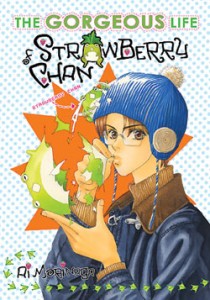 5. The Gorgeous Life of Strawberry-chan
5. The Gorgeous Life of Strawberry-chan
By Ai Morinaga • Media Blasters • 2 volumes
I didn’t think it was possible to dislike anything by Ai Morinaga, but this sadistic boarding-school comedy proved me wrong. There’s no real story here; most of the “action” revolves around Akiyoshi, a fatuous pretty boy, and Strawberry-Chan, his talking frog. Akiyoshi delights in torturing his pet, squashing Strawberry-Chan, burying him alive, and even inflating him like a balloon via a well-placed straw. (If Morinaga is trying to make a greater point with her hero’s perverse antics, I can’t imagine what it is.) Adding insult to injury is the art, which is a riot of misapplied screentones, clashing patterns, and extreme facial close-ups—it’s the best representation of a migraine I’ve ever seen committed to paper, but some of the worst sequential art I’ve seen, period. (Review originally posted at PopCultureShock, 5/31/08)
 4. J-Pop Idol
4. J-Pop Idol
Story by MILLENNI+ M, Art by Toko Tashiro • Tokyopop • 2 volumes
Until Tokyopop releases a Glitter Cinemanga, otaku eager for overripe musical drama will have to content themselves with J-Pop Idol. But unlike Glitter, which is bad in a jaw-dropping, can’t-take-my-eyes-off-it way, J-Pop Idol is just plain bad. A big part of the problem is the story, which has been hastily cobbled together from dozens of similar, Star Is Born narratives–so hastily, in fact, that many scenes feel like complete non-sequitors. One of the most egregious examples can be found in the very first pages, when the members of an up-and-coming girl group face a test of their friendship: after winning a major talent competition, only one of them is singled out for a recording contract. From the context, however, it’s impossible to see why producers chose Maki over band mates Kay and Naomi, as Maki lacks the charisma, talent, and sex appeal that distinguished Diana Ross from her fellow Supremes.
The rest of volume one charts Maki’s attempt to build a recording career under the tutelage of handsome idol Ken, who motivates his protege with tough talk and hard lessons. There’s also a subplot involving tuberculosis that might not seem out of place in a Joan Crawford weepie, but seems downright ludicrous in a manga aimed at a teenage audience. The bottom line: J-Pop Idol may have been a “#1 hit mobile manga in Japan,” but that endorsement carries about as much weight as Paula Abdul’s enthusiastic cheerleading on American Idol. (Review originally posted at PopCultureShock, 3/10/08)
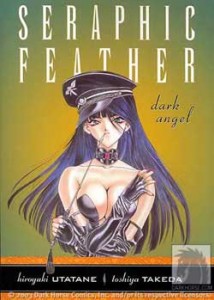 3. Seraphic Feather
3. Seraphic Feather
Art by Hiroyuki Utatane • Story by Yo Morimoto and Toshiya Takeda • Dark Horse • 6 volumes
Seraphic Feather has three strikes against it: an overly fussy plot, tin-eared dialogue, and lousy artwork. The story revolves around the discovery of an alien spaceship on the far side of the Moon. Various Earthly factions compete for the downed ship, hoping to unlock its powers using the Emblem Seeds, a high-protein energy bar a mysterious power source. Running in tandem with the main plot are a love story between a young man named Sunao and his childhood friend Kei — who mysteriously re-appears after dying in an explosion on the Moon — and a subplot involving Kei’s brother Apep, who mysteriously sprouts a pair of wings. Making these baroque plot twists harder to take is the dialogue, all of which sounds like it was pilfered from an episode of Mystery Science Theater 3000. The frosting on the cake, however, is the art: Hiroyuki Utatane seems more interested in drawing buxom girls and explosions than advancing the plot. Though characters yell and grab each other by the arm on almost every page, the story is dead in the water long before the end of volume one. Anyone who finds the cover art sexy will find the actual story an even bigger let-down, as it’s much tamer than the bustier and riding crop might suggest.
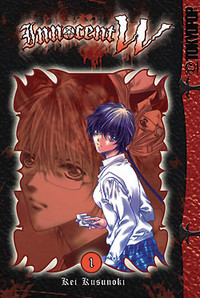 2. Innocent W
2. Innocent W
By Kei Kusonoke • Tokyopop • 4 volumes
I can’t decide if Kei Kusonoke is exceptionally efficient or just plain disgusting. To wit: on the very first pages of this three-volume series, she treats us to a panty shot of a girl with a gruesome injury. Things don’t improve much from there, as the story quickly devolves into a Wiccan Battle Royale, pitting a group of young witches against an assortment of sadistic weirdos in a remote, wooded area. The hunters rape, torture, and mutilate the young women for sport, leaving a trail of dismembered corpses in the forest before the survivors gain the upper hand. Perhaps more disturbing than the actual story is the artwork. Kusonoke lavishes considerable attention on the characters’ costumes and hairstyles, but can’t be bothered to endow their faces with any expression; it’s as if the entire cast consumed large amounts of valium right before the mayhem began. They look bored. Funny, I was too…
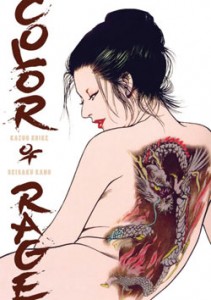 1. Color of Rage
1. Color of Rage
Story by Kazuo Koike • Art by Seisake Kano • Dark Horse • 1 volume
First published in 1973, this historical drama plays like a mash-up of The Last Samurai, Rush Hour, and Mandingo. The story begins in 1783, when a whaling ship goes down off the coast of Japan. Two men — George, who’s Japanese, and King, who’s African-American — wash ashore, cut off their shackles, and head inland, only to discover a landscape populated by unscrupulous samurai and feudal lords who hold the peasants in thrall. For such a far-fetched premise to work, its principal characters’ thoughts, words, and actions need to make sense in historical context. Yet George and King behave like two modern action heroes deposited in feudal Japan, not two products of the eighteenth century; it wouldn’t be much of a stretch to imagine John Cho and Will Smith slashing and wise-cracking their way through a big-screen adaptation. Making things worse are several scenes of brutal misogyny — what the editors euphemistically call “pulpy sexiness” — that are made all the more cringe-worthy by the unexamined racial stereotypes on parade. Kazuo Koike is always pushing the boundaries of good taste — that’s part of what makes Crying Freeman and Lady Snowblood so much fun — but Color of Rage sails way over the line and keeps on going. (Review originally posted at PopCultureShock, 5/18/08)
* * * * *
I’ll be the first to admit that this list reflects my own biases. I don’t have much patience for fanservice, sadism, or gore for gore’s sake; if I’m going to be treated to dismembered bodies and panty shots, there needs to be a story and some memorable characters for me to be on board with it. I realize that some folks don’t feel the same way as I do, and that’s OK. There’s plenty of room for all of us under the manga-loving tent, even if we can’t agree on whether Arm of Kannon is awesome or awful. (In other words: hate the manga, not the critic.)
So what manga belong on your all-time worst list and why? Inquiring minds want to know!
POSTSCRIPT, 9/28/09: Over at Okazu, Erica Friedman posts her Yuri Manga Hall of Shame, five blisteringly funny critiques of books like Suzunari and Alice on Deadlines. Go, read, and be glad you dodged a 4-koma manga about cat clone twincest.
 After reading Missin’ and Missin’ 2, I’m convinced that novelist Novala Takemoto was a teenage girl in a previous life. But not the kind of girl who was on the cheerleading squad, the volleyball team, or the school council — no, Takemoto was the too-cool-for-school girl, the one whose unique fashion sense, sullen demeanor, and indifference to high school mores made her seem more adult than her peers, even if her behavior and emotions were, in fact, just as juvenile as everyone else’s. Though this kind of angry female rebel is a stock character in young adult novels, Takemoto has a special gift for making them sound like real girls, not an adult’s idea of what a disaffected teenager sounds like.
After reading Missin’ and Missin’ 2, I’m convinced that novelist Novala Takemoto was a teenage girl in a previous life. But not the kind of girl who was on the cheerleading squad, the volleyball team, or the school council — no, Takemoto was the too-cool-for-school girl, the one whose unique fashion sense, sullen demeanor, and indifference to high school mores made her seem more adult than her peers, even if her behavior and emotions were, in fact, just as juvenile as everyone else’s. Though this kind of angry female rebel is a stock character in young adult novels, Takemoto has a special gift for making them sound like real girls, not an adult’s idea of what a disaffected teenager sounds like. Built in 1607, the Ooku, or “great interior,” housed the women of the Tokugawa clan, from the shogun’s mother to his wife and concubines. Strict rules prevented residents from fraternizing with outsiders, or leaving the grounds of Edo Castle without permission. Within the Ooku, an elaborate hierarchy governed day-to-day life; at the very top were the joro otoshiyori, or senior elders, who supervised the shogun’s attendants and served as court liaisons; beneath them were a web of concubines, priests, pages, cooks, and char women who hailed from politically connected families. This elaborate social system was mirrored in the physical structure of the Ooku, which was divided into three distinct areas — the Rear Quarters, the Middle Interior, and the Front Quarters — each intended solely ladies of a particular rank. The only male permitted into the Ooku (unescorted, that is), was the shogun himself, who accessed the “great interior” by means of the Osuzu Roka, a long corridor that connected the shogun’s living quarters with the imperial harem.
Built in 1607, the Ooku, or “great interior,” housed the women of the Tokugawa clan, from the shogun’s mother to his wife and concubines. Strict rules prevented residents from fraternizing with outsiders, or leaving the grounds of Edo Castle without permission. Within the Ooku, an elaborate hierarchy governed day-to-day life; at the very top were the joro otoshiyori, or senior elders, who supervised the shogun’s attendants and served as court liaisons; beneath them were a web of concubines, priests, pages, cooks, and char women who hailed from politically connected families. This elaborate social system was mirrored in the physical structure of the Ooku, which was divided into three distinct areas — the Rear Quarters, the Middle Interior, and the Front Quarters — each intended solely ladies of a particular rank. The only male permitted into the Ooku (unescorted, that is), was the shogun himself, who accessed the “great interior” by means of the Osuzu Roka, a long corridor that connected the shogun’s living quarters with the imperial harem.
 Highbrow, lowbrow… and everything in between. That’s the slogan of
Highbrow, lowbrow… and everything in between. That’s the slogan of 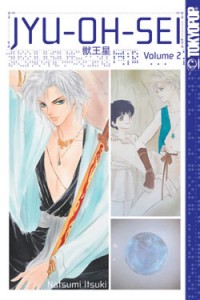 Though the story is well-executed, the artwork is something of a disappointment. Itsuki goes to great pains to create a diverse cast — a task at which she’s generally successful — but her character designs are generic and dated; I’d be hard-pressed to distinguish the Kimaerans from, say, the cast of RG Veda or Basara. Itsuki also struggles with skin color; her dark-skinned women bear an unfortunate resemblance to kogals, thanks to Itsuki’s clumsy application of screentone.
Though the story is well-executed, the artwork is something of a disappointment. Itsuki goes to great pains to create a diverse cast — a task at which she’s generally successful — but her character designs are generic and dated; I’d be hard-pressed to distinguish the Kimaerans from, say, the cast of RG Veda or Basara. Itsuki also struggles with skin color; her dark-skinned women bear an unfortunate resemblance to kogals, thanks to Itsuki’s clumsy application of screentone. In the year 2346 A.D., humans have colonized the Vulcan solar system, a region so inhospitable that the average life span is a mere thirty years. Rai and Thor, whose parents belong to Vulcan’s ruling elite, enjoy a life of rare privilege — that is, until a political rival executes their parents and exiles the boys to Kimaera, a penal colony reserved for violent criminals. To say Kimaera’s climate is harsh understates the case: daylight lasts for 181 days, producing extreme desert conditions and water shortages, while nighttime plunges Kimaera into arctic darkness for an equal length of time. Making the place even more treacherous is the flora, as Kimaera’s jungles team with carnivorous plants capable of eating humans whole.
In the year 2346 A.D., humans have colonized the Vulcan solar system, a region so inhospitable that the average life span is a mere thirty years. Rai and Thor, whose parents belong to Vulcan’s ruling elite, enjoy a life of rare privilege — that is, until a political rival executes their parents and exiles the boys to Kimaera, a penal colony reserved for violent criminals. To say Kimaera’s climate is harsh understates the case: daylight lasts for 181 days, producing extreme desert conditions and water shortages, while nighttime plunges Kimaera into arctic darkness for an equal length of time. Making the place even more treacherous is the flora, as Kimaera’s jungles team with carnivorous plants capable of eating humans whole. Tegami Bachi has all the right ingredients to be a great shonen series: a dark, futuristic setting; rad monsters; cool weapons powered by mysterious energy sources; characters with goofy names (how’s “Gauche Suede” grab you?); and smart, stylish artwork. Unfortunately, volume one seems a little underdone, like a piping-hot shepherd’s pie filled with rock-hard carrots.
Tegami Bachi has all the right ingredients to be a great shonen series: a dark, futuristic setting; rad monsters; cool weapons powered by mysterious energy sources; characters with goofy names (how’s “Gauche Suede” grab you?); and smart, stylish artwork. Unfortunately, volume one seems a little underdone, like a piping-hot shepherd’s pie filled with rock-hard carrots.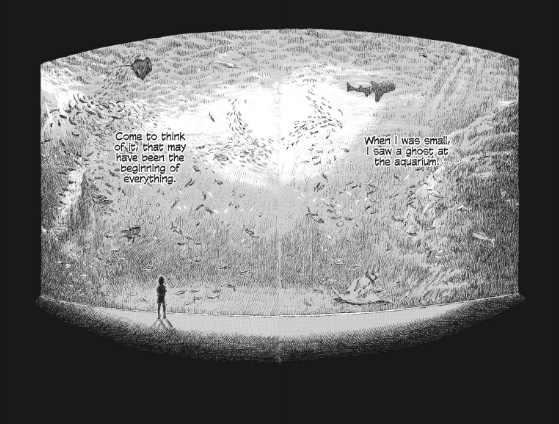
 The ocean occupies a special place in the artistic imagination, inspiring a mixture of awe, terror, and fascination. Watson and the Shark, for example, depicts the ocean as the mouth of Hell, a dark void filled with demons and tormented souls, while The Birth of Venus offers a more benign vision of the ocean as a life-giving force. In Children of the Sea, Daisuke Igarashi imagines the ocean as a giant portal between the terrestrial world and deep space, as is suggested by a refrain that echoes throughout volume one:
The ocean occupies a special place in the artistic imagination, inspiring a mixture of awe, terror, and fascination. Watson and the Shark, for example, depicts the ocean as the mouth of Hell, a dark void filled with demons and tormented souls, while The Birth of Venus offers a more benign vision of the ocean as a life-giving force. In Children of the Sea, Daisuke Igarashi imagines the ocean as a giant portal between the terrestrial world and deep space, as is suggested by a refrain that echoes throughout volume one: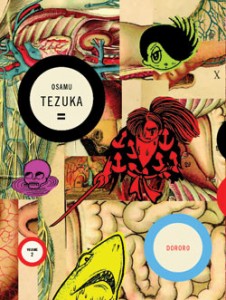 Though much of the devastation that Hyakkimaru and Dororo witness is man-made (Dororo takes placed during the Sengoku, or Warring States, Period), demons exploit the conflict for their own benefit, holding small communities in their thrall, luring desperate travelers to their doom, and feasting on the never-ending supply of human corpses. Some of these demons have obvious antecedents in Japanese folklore — a nine-tailed kitsune — while others seem to have sprung full-blown from Tezuka’s imagination — a shark who paralyzes his victims with sake breath, a demonic toad, a patch of mold possessed by an evil spirit. (As someone who’s lived in prewar buildings, I can vouch for the existence of demonic mold. Lysol is generally more effective than swordplay in eliminating it, however.) Hyakkimaru has a vested interest in killing these demons, as he spontaneously regenerates a lost body part with each monster he slays. But he also feels a strong sense of kinship with many victims — a feeling not shared by those he helps, who cast him out of their village as soon as the local demon has been vanquished.
Though much of the devastation that Hyakkimaru and Dororo witness is man-made (Dororo takes placed during the Sengoku, or Warring States, Period), demons exploit the conflict for their own benefit, holding small communities in their thrall, luring desperate travelers to their doom, and feasting on the never-ending supply of human corpses. Some of these demons have obvious antecedents in Japanese folklore — a nine-tailed kitsune — while others seem to have sprung full-blown from Tezuka’s imagination — a shark who paralyzes his victims with sake breath, a demonic toad, a patch of mold possessed by an evil spirit. (As someone who’s lived in prewar buildings, I can vouch for the existence of demonic mold. Lysol is generally more effective than swordplay in eliminating it, however.) Hyakkimaru has a vested interest in killing these demons, as he spontaneously regenerates a lost body part with each monster he slays. But he also feels a strong sense of kinship with many victims — a feeling not shared by those he helps, who cast him out of their village as soon as the local demon has been vanquished.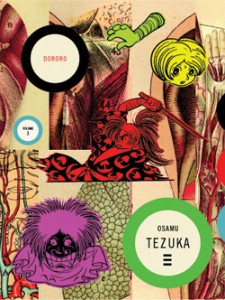 For folks who find the cartoonish aspects of Tezuka’s style difficult to reconcile with the serious themes addressed in Buddha, Phoenix, and Ode to Kirihito, Dororo may prove a more satisfying read. The cuteness of Tezuka’s heroes actually works to his advantage; they seem terribly vulnerable when contrasted with the grotesque demons, ruthless samurai, and scheming bandits they encounter. Tezuka’s jokes — which can be intrusive in other stories — also prove essential to Dororo‘s success. He shatters the fourth wall, inserts characters from his stable of “stars,” borrows characters from other manga-kas’ work, and punctuates moments of high drama with low comedy, underscoring the sheer absurdity of his conceits… like sake-breathing shark demons. Put another way, Dororo wears its allegory lightly, focusing primarily on swordfights, monster lairs, and damsels in distress while using its historical setting to make a few modest points about the corrosive influence of greed, power, and fear.
For folks who find the cartoonish aspects of Tezuka’s style difficult to reconcile with the serious themes addressed in Buddha, Phoenix, and Ode to Kirihito, Dororo may prove a more satisfying read. The cuteness of Tezuka’s heroes actually works to his advantage; they seem terribly vulnerable when contrasted with the grotesque demons, ruthless samurai, and scheming bandits they encounter. Tezuka’s jokes — which can be intrusive in other stories — also prove essential to Dororo‘s success. He shatters the fourth wall, inserts characters from his stable of “stars,” borrows characters from other manga-kas’ work, and punctuates moments of high drama with low comedy, underscoring the sheer absurdity of his conceits… like sake-breathing shark demons. Put another way, Dororo wears its allegory lightly, focusing primarily on swordfights, monster lairs, and damsels in distress while using its historical setting to make a few modest points about the corrosive influence of greed, power, and fear. If Phoenix is Tezuka’s Ring Cycle, Wagnerian in scope, form, and seriousness, then Dororo is Tezuka’s Don Giovanni, a playful marriage of supernatural intrigue and lowbrow comedy whose deeper message is cloaked in shout-outs to fellow artists (in this case,
If Phoenix is Tezuka’s Ring Cycle, Wagnerian in scope, form, and seriousness, then Dororo is Tezuka’s Don Giovanni, a playful marriage of supernatural intrigue and lowbrow comedy whose deeper message is cloaked in shout-outs to fellow artists (in this case,